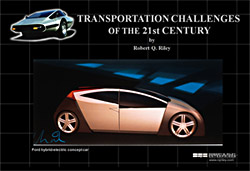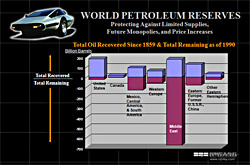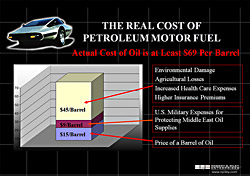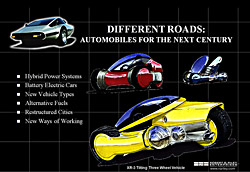SLIDES IN THIS PRESENTATION
Transportation Challenges of the 21st Century
 I was looking around at the cars on display here this morning, and I was thinking about a presentation I gave at a J.D. Power’s Powertrain Seminar in May of 1997. In my presentation there was a slide showing a futuristic hybrid car, and I said to the folks in attendance: “If we had to build a hybrid vehicle tomorrow, this is how it would be built.” At the time, hybrids were still highly experimental and everyone believed it would be several years before anyone could actually buy one. Well that was only 2-1/2 years ago, and the Toyota Prius and Honda Insight - hybrid-electric cars with a range limited only by the amount of fuel on board - will begin showing up on showroom floors in the U.S within the next few months. In just a few months, you’ll be able to walk into your local car store and buy one of these advanced hybrid cars. I was looking around at the cars on display here this morning, and I was thinking about a presentation I gave at a J.D. Power’s Powertrain Seminar in May of 1997. In my presentation there was a slide showing a futuristic hybrid car, and I said to the folks in attendance: “If we had to build a hybrid vehicle tomorrow, this is how it would be built.” At the time, hybrids were still highly experimental and everyone believed it would be several years before anyone could actually buy one. Well that was only 2-1/2 years ago, and the Toyota Prius and Honda Insight - hybrid-electric cars with a range limited only by the amount of fuel on board - will begin showing up on showroom floors in the U.S within the next few months. In just a few months, you’ll be able to walk into your local car store and buy one of these advanced hybrid cars.
Today, automotive technology is on the verge of a giant leap forward that could be as revolutionary as when the carriage gave up the horse at the beginning of the 20th century. And it will not only involve new power systems, but it will probably include new vehicle types - personal vehicles that we’ve only barely envisioned at this point - and perhaps even a restructuring of cities and the way we do business.
This morning I’m going to talk a little about why it’s happening now…. Why it has to happen now and not 10 or 15 years hence…... Why we’re investing huge resources through PNGV and other programs in what almost amounts to a mini-going-to-the-moon effort…... And why we’re doing it at a time when gasoline is plentiful and the price of oil is at a 40-year low.
So my role this morning is to get everyone depressed. A few weeks ago, Christopher Mount, the curator responsible for the Different Roads exhibit here, called me and said: “I read the first chapter of your book, and I’m so depressed I don’t think I can go on… you’re just the right man for the job.” So if you woke up thinking that everything was pretty much okay, my job is to explain why it’s not…. Why we are facing challenges today that are unlike anything that has ever been experienced in human history.
Basically, these new ideas in transportation are designed to solve problems. If we didn’t have problems, we could continue on with business as usual. If it wasn’t broken, we wouldn’t have to fix it. To put it in the logic of Yogi Bera, “the problem is that everyone wants to be somewhere else – and there’s six billion of us - and pretty soon there will be 10 billion of us.” So the goal of these new approaches to personal mobility is to create a sustainable and environmentally-benign transportation system – because the one we have is not sustainable over the long term…... It’s certainly not environmentally-benign (or even a little bit friendly)… And we haven’t seen the worst of it yet. And in a few years, it could cause political, economic, and environmental problems like we’ve never seen before, unless we do something now.
World Car Population
 This is the first part of the problem. This slide shows the worldwide growth in automobile population. In North America and Western Europe, the number of automobiles is growing at slightly less than twice the rate of the human population. But in the developing world, growth is almost exponential because of expanding economic growth. Remember when things were manufactured in Japan in order to get it done at the lowest possible price. Then after Japan’s economy awakened and the cost of labor went up, low-cost manufacturing moved to Taiwan. Today it’s Cambodia, Thailand, and China. What happens is that heavy industry follows cheap labor around the world, which improves the local economy. And one of the first things they buy with their newfound wealth is a car. So in the developing world, car populations are increasing more in proportion to the growth of the economy, not the growth of their population. They already have plenty of people. All they need is a job so they can buy a car. This is the first part of the problem. This slide shows the worldwide growth in automobile population. In North America and Western Europe, the number of automobiles is growing at slightly less than twice the rate of the human population. But in the developing world, growth is almost exponential because of expanding economic growth. Remember when things were manufactured in Japan in order to get it done at the lowest possible price. Then after Japan’s economy awakened and the cost of labor went up, low-cost manufacturing moved to Taiwan. Today it’s Cambodia, Thailand, and China. What happens is that heavy industry follows cheap labor around the world, which improves the local economy. And one of the first things they buy with their newfound wealth is a car. So in the developing world, car populations are increasing more in proportion to the growth of the economy, not the growth of their population. They already have plenty of people. All they need is a job so they can buy a car.
But the slide only shows the population of cars - not the total motor vehicle population. By 2020 there will be well over 1.1 billion motor vehicles in the world! If they all lined up and drove past you at the rate of one vehicle per second, it would take 35 years for 1.1 billion motor vehicles to drive by. And if they lined up bumper-to-bumper for the drive-by, the line would extend 130 times around the world. That’s how many motor vehicles we’ll have to keep supplied with motor fuel in year 2020. And that’s how many motor vehicles will be manufacturing atmospheric pollutants. And the number will still be rapidly growing.
I’ll give you a superlative, just because it boggles the mind - but don’t ask me if it’s likely to happen - I can’t envision how it could. The U.N. expects population to stabilize at around 10 billion people. If the numbers do reach 10 billion, and the world’s economy keeps improving to the point that everyone owns cars at the rate of Americans in the 1990s, there would be 6 billion cars or about 8 billion motor vehicles in the world - over ten times more than today. And if everyone drove like Americans in the 90s, that would suck the entire Middle East oil supplies dry in about 5 years.
But back to reality, and something that we can actually deal with. Today, the transportation sector is almost totally dependent on petroleum motor fuels. With modern emission controls and fuel formulations, gasoline-cars have become pretty clean. Controlled emissions have been cut by about 95 percent in the last 20 years. But on a global scale, recent gains could be wiped out within a decade or so because of the increased numbers of cars in the developing world. And emissions of greenhouse gases, mainly CO2, will go right through the ceiling in the next 20 years, unless we dramatically reduced energy consumption. And if we continue with today’s upward spiral in oil consumption, we’re headed for an enormous transfer of economic power and wealth to the OPEC nations.
World Petroleum Reserves
 This accelerated growth in the world’s automobile population is accelerating the pressure on finite oil reserves, which is the next part of the problem. There are two interrelated issues involved. One is limited supplies, which is very controversial, and the other is economic vulnerability and the transfer of wealth to the holders of the largest reserves - mainly OPEC. This accelerated growth in the world’s automobile population is accelerating the pressure on finite oil reserves, which is the next part of the problem. There are two interrelated issues involved. One is limited supplies, which is very controversial, and the other is economic vulnerability and the transfer of wealth to the holders of the largest reserves - mainly OPEC.
The earth’s total original endowment of oil probably amounts to about 2.1 to 2.8 trillion barrels. As of 1998, we had already used over 800 billion barrels, and about same amount remained in the ground as proven reserves. The rest of the oil hasn’t been found yet, but experts believe it’s there (about .5 to 1.2 trillion barrels of undiscovered oil).
It’s generally agreed that production will begin a permanent decline and prices will begin a permanent upward spiral when roughly half the earth’s total endowment of oil has been consumed (1 to 1.5 trillion barrels). Based on that idea, we could expect to see escalating prices and a permanent global decline in oil production about 2010 (at about 1.2 trillion barrels) - which wouldn’t stack up very well against increasing demand. But new recovery techniques will probably push the envelope out to 2020 - perhaps even further.
If consumption continues to increase past year 2020, and we haven’t switched to more efficient technology, it’ll take only 21 years to consume an amount of oil equal to all the oil consumed in the entire 20th century (about 900 billion barrels). And transportation will be consuming at least 60 percent of it. So the end of the line for cheap crude is somewhere out there, and by switching to more efficient transportation technologies we can extend the envelope and buy time to develop even better solutions. We’re talking about changing over an enormous energy supply infrastructure, a vehicle technology and manufacturing base, and an economic structure. So it’s important to cut consumption so we can avoid serious supply and economic disruptions later on.
Economic vulnerability and the transfer of wealth is probably a more immediate problem. OPEC owns about 75 percent of the proven reserves, and according to the latest estimates, they will be supplying at least half the world’s oil by 2020. And without a switch to new technology, transportation will be using almost 60 percent of the total oil supply. This raises important questions about energy security, price stability, balance of payments, and the vulnerability of our economic system to political instability in the Middle East. Is it really in our best interests rely so heavily on the Middle East for such an essential resource? Can we afford to allow runaway balance of payments shortfalls to put the entire industrialized world in debt to the OPEC nations? And what are the implications for military expenses? U.S. military expenses for protecting Middle East oil already calculate out to about $9 per barrel of imported oil (it’s true - $9 per barrel), and today we have other options on where to get oil. But what might we be compelled to spend when our options are more limited?
So any way you turn it, we will be facing big challenges with motor fuel supplies in the next century, either in the form of political problems due to diminishing supplies and regional monopolies, much higher costs, accelerated environmental damage or some combination of all of them. So it’s in our best interests to reduce energy consumption and move away from this total reliance on petroleum motor fuels. And it’s also in our best interests in terms of preserving our most essential resource of all - the health of our only planet.
Greenhouse Emissions and Global Warming
 Preserving the health of our planet is another big factor driving the change in transportation technology. Petroleum motor fuels produce harmful emissions, not the least of which is emissions of greenhouse gases. There are lots of other problems caused by harmful emissions - damage from acid rain, respiratory problems and increased health care costs due to air pollution - but global warming is potentially the most disastrous, and it’s one of the most controversial. Preserving the health of our planet is another big factor driving the change in transportation technology. Petroleum motor fuels produce harmful emissions, not the least of which is emissions of greenhouse gases. There are lots of other problems caused by harmful emissions - damage from acid rain, respiratory problems and increased health care costs due to air pollution - but global warming is potentially the most disastrous, and it’s one of the most controversial.
There are lots of gases that contribute to the greenhouse effect - some man made and some naturally occurring. Asking what causes the greenhouse effect is sort of like asking what causes cancer. Almost everything including barbecued hamburgers and too much exercise has been implicated in cancer. So it’ll come as a big relief to learn that animal flatulence causes global warming due to increased methane in the air. It’s not all our fault. And even global warming itself causes global warming because when the planet’s hotter, the oceans evaporate faster, and airborne water vapor is a powerful greenhouse gas. So it’s a complex issue, and there’s plenty of material for turning it into something less than the serious matter that it is. But like cancer, once you get it, it’s hard to get rid of it... and it can forever change our lives.
Carbon dioxide (CO2) is the most troublesome greenhouse gas that comes from human activities. From the last ice age until the industrial revolution in the last century (about 10,000 years), the atmospheric level of CO2 had varied only about 5%. But beginning with the industrial revolution and projecting forward to about 2030, the amount of atmospheric CO2 will have doubled - all in about 150 years time.
Global warming and the resulting climatic changes are about as close to proven as something like this can be, and the post-industrial increase in greenhouse gases looks like the culprit. One of the biggest contributions that humans are making to the rise in atmospheric levels of CO2 is the burning of fossil fuels. With hydrocarbon fuels, C02 emissions are roughly proportional to the amount of energy consumed. So with a fossil-fuel-based energy system - and about 86 percent of the world’s energy comes from fossil fuels (39% oil, 22% natural gas, 25% coal) - an increase in energy consumption naturally increases CO2 emissions. And when carbon dioxide is released into the atmosphere, it doesn’t degrade like some of these other pollutants. Instead, it hangs around for 100 to 200 years. So even if we stopped these emissions today, we would be forced to deal with the effects for several generations into the future.
The main problem with global warming isn’t that it will be a little hotter than usual. We can always dump a little more energy into the air conditioning unit. The most devastating effects will come from shifts in the earth’s weather patterns. At the very least, rainfall patterns will migrate toward the poles, and away from the best agricultural lands on the planet. So food production will decline. But we’re in really deep trouble if the ocean and atmospheric flows responsible for our global weather system ever change. We don’t have a clue what we’ll end up with. But once it happens, it will be very difficult if not impossible to reverse. And it could happen quite suddenly once we reach a critical threshold.
The Real Cost of Petroleum Motor Fuel
 Most of us think that the cost of gasoline is about $1.40 per gallon (the price in 1999 when this presentation was delivered). This retail price is based on production costs, delivery to local service stations, taxes, and profits throughout the system. But like taxes, a lot of the costs of our petroleum-based energy system are hidden. They don’t show up in the price we pay at the pumps. Instead, they’re paid in other ways. Most of us think that the cost of gasoline is about $1.40 per gallon (the price in 1999 when this presentation was delivered). This retail price is based on production costs, delivery to local service stations, taxes, and profits throughout the system. But like taxes, a lot of the costs of our petroleum-based energy system are hidden. They don’t show up in the price we pay at the pumps. Instead, they’re paid in other ways.
A number of studies have attempted to estimate the environmental costs of burning oil. But the resulting figures vary widely because it all depends on the value you place on particular environmental losses. And it’s difficult to determine the increase in health care costs that are directly related to the pollution from burning oil. But a conservative estimation is that environmental degradation translates into real costs that factor out to about $45 per barrel of oil. In other words, we can add $45 to the cost of a barrel of oil just to pay for the resulting environmental damage.
Another cost paid through higher taxes, instead of through higher motor fuel prices, is the military expenses that are directly related to protecting Middle East oil supplies. We’d have military expenses anyway, even if we didn’t have to pay for protecting oil supplies. But if we isolate only those expenses that are directly related to protecting Middle East oil interests, it factors out to about $9 per barrel of imported oil.
The estimates vary widely on how this would affect motor fuel prices if all the related costs were factored in. I’ve seen figures as low as $10 - $12 per gallon, up to as high as $16 per gallon. But the reality is that we’re paying for it anyway - through higher insurance premiums, increased health care expenses, and higher taxes.
These estimations are based on the level of military expenses, health care costs, and environmental damage today. But in many cases, we’re just letting the damage build up for future generations to pay. And the effects of global warming could send these costs right through the ceiling over the next 25 years or so. So it really comes down to the question of whether we can actually afford to continue with this petroleum-based energy system. My sense of it is that, even with more expensive vehicle technologies and more costly alternative fuels, we’ll be saving a bundle of money by moving away from oil, not to mention the improvement in air quality and the security of having a long-term sustainable energy system.
Different Roads: Automobiles for the Next Century
 So when we look at the entire picture, there are compelling reasons for today’s rapid development of new transportation technologies. One doesn’t have to subscribe to the Malthusian meltdown theory in order to appreciate the challenges. Ultimately, the justification comes down to the task of insuring stability, predictability, and sustainability over the long haul. It’s in our own interests to create a more energy efficient and sustainable system. And I think it even makes sense in terms of corporate profits. So when we look at the entire picture, there are compelling reasons for today’s rapid development of new transportation technologies. One doesn’t have to subscribe to the Malthusian meltdown theory in order to appreciate the challenges. Ultimately, the justification comes down to the task of insuring stability, predictability, and sustainability over the long haul. It’s in our own interests to create a more energy efficient and sustainable system. And I think it even makes sense in terms of corporate profits.
Lots of brilliant people are at work with good ideas and new approaches on how to solve the world’s transportation challenges. The vehicles you see on display in the Different Roads exhibit are just the tip of the iceberg. And there’s a sense of adventure coming from everyone involved in this search for a new paradigm for personal transportation.
And on a personal level, I’m often struck by how this planet of ours has provided a cheap easy-to-use resource when we needed it to make the transition into the age of technology. It would have been very difficult if petroleum hadn’t sort of shot out of the ground and landed in our laps. But my sense of it is that the earth hasn’t given us enough of it to let us totally burn our house down. Instead, it’s demanding greater excellence in the way we do things, and at a time when we’re able to meet the challenge.
|